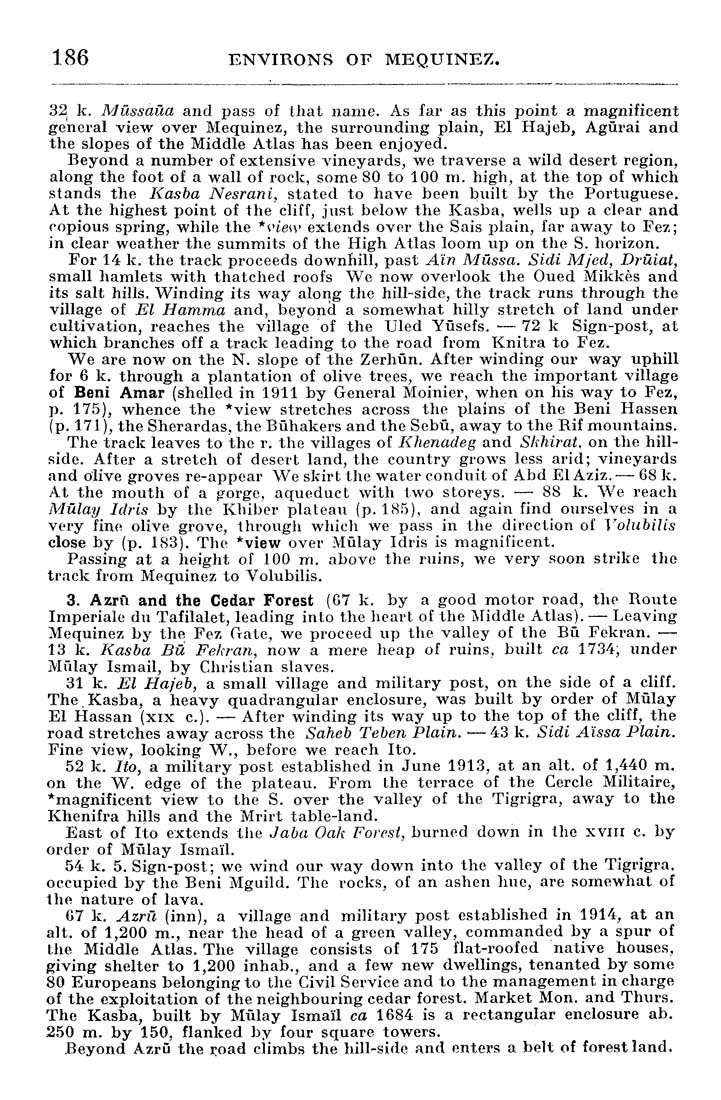186 ENVIRONS OF MEQUINEZ.
32 k. MUssaUa and pass of that name. As far as this point a magnificent
general view over Mequinez, the surrounding plain, El Hajeb, Agiirai and
the slopes of the Middle Atlas has been enjoyed.
Beyond a number of extensive vineyards, wo traverse a wild desert region,
along the foot of a wall of rock, some 80 to 100 m. high, at the top of which
stands the Kasba Nesrani, stated to have been built by tho Portuguese.
At the highest point of the cliff, just below the Kasba, wells up a clear and
copious spring, while the *view extends over the Sais plain, far away to Fez;
in clear weather the summits of the High Atlas loom up on the S. horizon.
For 14 k, the track proceeds downhill, past Ain Miissa. Sidi Mjed, Druiat,
small hamlets with thatched roofs We now overlook the Oued Mikkes and
its salt hills. Winding its way along the hill-side, tho track runs through the
village of El Hamma and, beyond a somewhat hilly stretch of land under
cultivation, reaches the village of the Uled Yiisefs. — 72 k Sign-post, at
which branches off a track leading to tho road from Knitra to Fez.
We are now on the N. slope of the Zerhiin. After winding our way uphill
for 6 k. through a plantation of olive trees, we reach the important village
of Beni Amar (shelled in 1911 by General Moinier, when on his way to Fez,
p, 175), whence the *view stretches across the plains of the Beni Hassen
(p, 171), the Sherardas, tho Biihakors and tho Sebii, away to the Rif mountains.
The track leaves to the r. tho villages of Khenadeg and Skhirat, on the hill¬
side. After a stretch of desert land, the country grows less arid; vineyards
and olive groves re-appoar We skirt tho water conduit of Abd El Aziz.— 68 k.
At the mouth of a gorge, aqueduct with two storeys. — 88 k. Wo reach
Mulay Idris by tho Khiber plateau (p. 185), and again find ourselves in a
very fine olive grove, through which we pass in the direction of Volubilis
close by (p, 183), Tho *view over Miilay Idris is magnificent.
Passing at a height of 100 m. above the ruins, we very soon strike the
track from Mequinez to Volubilis,
3, Azrii and the Cedar Forest (07 k. by a good motor road, tho Route
Imperiale du Tafilalet, leading into the heart of the INfiddle Atlas). — Leaving
Mequinez by the; Fez Gate, we proceed up tho valley of the Bu Fekran. —
13 k. Kasba Bii Fekraji, now a mere heap of ruins, built ca 1734, under
Mulay Ismail, by Christian slaves.
31 k. El Hajeb, a small village and military post, on the side of a cliff.
The Kasba, a heavy quadrangular enclosure, was built by order of Miilay
El Hassan (xix c). — After winding its way up to the top of the cliff, the
road stretches away across tho Saheb Teben Plain. —43 k. Sidi Aissa Plain.
Fine view, looking W., before we reach Ito.
52 k. Ito, a military post established in June 1913, at an alt, of 1,440 m.
on the W, edge of the plateau. From tho terrace of the Cercle Militaire,
*magnificent view to the S, over the valley of the Tigrigra, away to the
Khenifra hills and the Mrirt table-land.
East of Ito extends the Jaba Oak Forest, burned down in the xviii c, by
order of Mulay Ismail,
54 k, 5, Sign-post; we wind our way down into the valley of the Tigrigra,
occupied by the Beni Mguild, Tho rocks, of an ashen hue, are somewhat of
the nature of lava.
67 k, AzriL (inn), a village and mihtary post established in 1914, at an
alt. of 1,200 m,, near the head of a green valley, commanded by a spur of
the Middle Atlas, The village consists of 175 flat-roofed native houses,
giving shelter to 1,200 inhab,, and a few new dwellings, tenanted by some
80 Europeans belonging to the Civil Service and to the management in charge
of the exploitation of the neighbouring cedar forest. Market Mon. and Thurs,
The Kasba, built by Mulay Ismail ca 1684 is a rectangular enclosure ab,
250 m. by 150, flanked by four square towers.
Beyond Azrii the road climbs the hill-side and enters a belt of forest land.
|








